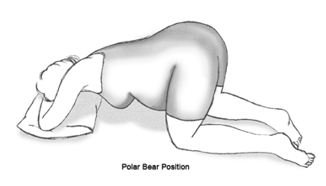Positions for the Birthing Phase
Birth is not an athletic event, and there is no need to become involved with gymnastics-like positions as you birth your baby. Just as you calmly experienced the opening and thinning phase of your labor, the time you spend in birthing your baby can be equally as calm if you maintain control over what is happening and resist the early attempts of others to “take charge.” Your breathing will be mother-directed Birth Breathing that will assist you in gently bringing about the descent of your baby.
Nothing needs to change until the baby’s descent is complete, and he is crowning. The important factor in birthing is how comfortable you feel in the birthing position that you choose and how you feel you can best assist in the baby’s emergence.
There are several positions that you can adopt during the birthing phase of labor that actually enhance the widening of the birth path and shorten this phase of labor. They also reduce the likelihood of an episiotomy.
For many years the most common positions used for birthing were those preferred by the medical caregivers—chosen for the ease of technical applications and instruments. While the methodology changed, the positions remained the same with women on their backs in a lithotomic position, their legs being folded back or elevated in any number of ways. Today with HypnoBirthings, we are seeing large numbers of caregivers who are responsive to the birthing mother’s lead, and they attend from whatever position the mother is comfortable in or feels she wants to assume. The supine position, nearly flat on your back and with feet in stirrups, is most assuredly a thing of the past, and rightly so. It is the least effective and increases the likelihood of having an episiotomy.
The positions described and illustrated here may require practice with your birth companion to tone your legs or your arms, but you will value this well-spent practice when you are birthing.
Semi-Reclining (Slanted “J”): When your baby is coming smoothly and easily, this very frequently used position will help you to maintain your deep relaxation during the time that you are breathing your baby down. The slanted “J” places you on a bed, resting just above your tailbone, with pillows behind your head, shoulders and back. The head of the bed is elevated to a 45-degree angle. Usually your legs are gently spread apart with a pillow under each knee. This position can be modified into a semi-squatting position by placing your ankles against your buttocks and spreading your legs and feet wide and to the side. This position also widens and stretches the pelvic area.
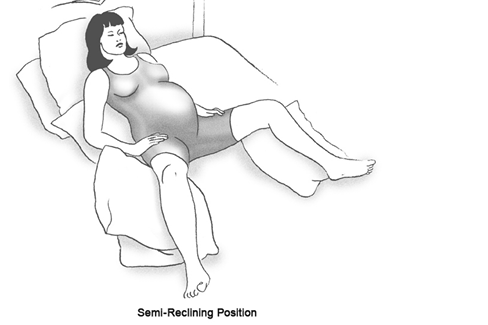
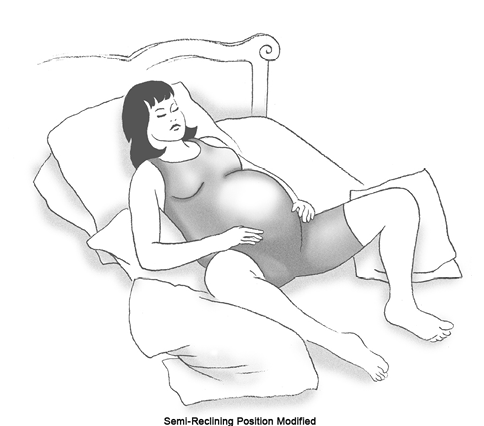
Lateral: You may be quite accustomed to this position, as many mothers tell us that they have been sleeping in a variation of the Lateral position for some time. This is also the position that many moms prefer during relaxation sessions. Birthing in the Lateral position is a frequent choice because of the ease with which you are able to move smoothly from the opening phase directly into breathing your baby down through the birth path without having to change positions. For birthing, the leg that you rested on pillows during labor is held up slightly to provide clear access to the vaginal outlet once the baby has completely descended. Until that time, you may remain just as you are with legs on pillows.
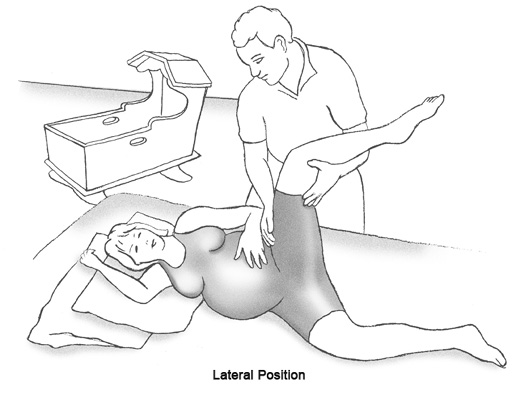
Leaping Frog: This position is an easy form of squatting, which some experts believe is one of the most effective positions for bringing your baby into the world. While squatting on your toes, place your arms inside or outside of your legs and support yourself on your hands. When your arms are outside and slightly back at the side of your hips, it is easy to spread your legs wide and allows you a clear view of your baby’s birth. Another advantage of the Leaping Frog with arms outside is that your entire lower pelvic area is suspended, leaving your baby to finally emerge without pressure from other parts of your body. This position widens the vaginal opening, utilizes the effect of gravity, shortens the birth path, and places the lower body up and away from any pressure. If you think you may utilize the Leaping Frog position, you will want to practice it regularly to strengthen your arm muscles, but it is worth any effort you may put into it.
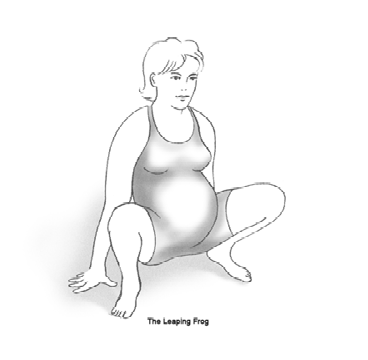
Supported Squat: With all of the advantages of the Leaping Frog position, your baby can easily emerge in birth with your assuming the Supported Squat position. Instead of using your arms to support your body, you can nicely support yourself by resting your arms, bent at the elbows, on your birth companion’s upper leg while he/she sits at the edge of a low chair if you are birthing at home, or at the edge of the lowered hospital bed if you are at a birthing facility. This position allows you to lean back against your partner between surges and readily return to the position when a new surge comes. From this position your baby can birth with the same advantages of using the Leaping Frog position.
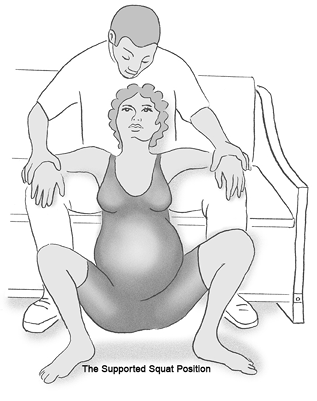
Toilet Sitting: Many women find a great deal of comfort in Toilet Sitting while they are still in the opening phase and while breathing their baby down. The body naturally responds to this position as it is conditioned to release and let go when toileting. This is a familiar position and location for HypnoBirthing moms because they are advised to practice their Birth Breathing while they are sitting on the toilet, moving their bowels. The two sets of muscles are closely related, and the Natural Expulsive Reflex (NER) present in birthing is supported by Birth Breathing. This position can offer the kind of spread that helps your pelvic area, opens your vagina, utilizes gravity and relieves you from having to support yourself on your legs. Just place a pillow or two behind your back and relax. As you near the crowning period, you will have to assume another of the birthing positions in order to safely birth your baby.
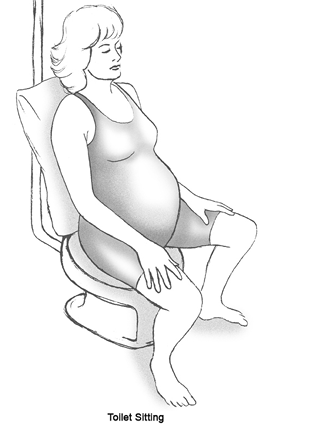
Birthing Stool: The Birthing Stool has many of the same advantages as Toilet Sitting in that it widens the pelvic area and shortens the birth path. Additionally, it allows the mom to have the security and confidence that comes from being able to lean back against her partner between surges. Like Toilet Sitting, this is a familiar position for the birthing mother because she used this to practice Birth Breathing.
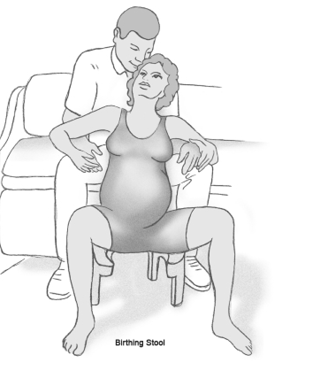
Hands-and-Knees: This position can easily be assumed from the Leaping Frog position by simply moving forward on your hands and bringing the lower part of your body up and forward over your knees in an all-fours stance. In this position, you will be on all fours leaning your weight on your knees and on your palms. This position is frequently used by women who have hired midwives as their birth attendants. This is a good position to assume if your baby needs an assist to get into an optimal position for emerging. You can also enjoy a modified version of the Hands-and-Knees position by leaning over a birthing ball. Hospital beds can sometimes be adjusted to accommodate this position. If you are birthing at home, kneeling on a pillow with your arms and upper body supported on another pillow on a chair will give the same effect.
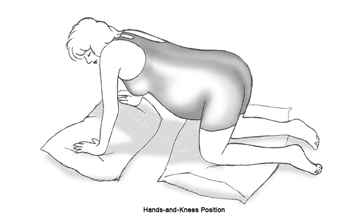
Supported Stand: The Supported Stand utilizes the advantages of gravity in helping the baby move down the birth path. It involves having your partner support himself by leaning against a wall and extending his arms. You can support yourself on his arms by leaning back against him while you rest your underarms on his lower arms. You both will want to flex your legs at the knees slightly.
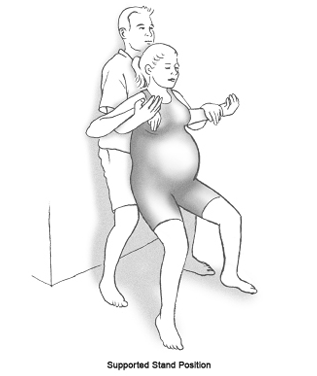
Polar Bear: While the Polar Bear position is not a birthing position, it can be helpful if the baby is found to be in a less than optimal position for emergence. This favorable position can be assumed from a Hands-and-Knees position by placing your forearms on the floor in front of you and resting your forehead on your hands. Both the Polar Bear and the Hands-and-Knees position allow your baby to move back from the lower pelvic area and turn to a more beneficial position for birthing if this is needed.
If the baby does need an assist to move to a more optimal position, the Rebozo technique can be nicely utilized while mom is in the Polar Bear position. The technique, developed by midwife Guadalupe Trueba, is well known in Mexico and is fast making its way into birthing rooms in the United States. It is simply done by placing a long scarf under the mother’s abdomen at the area of the pelvic region and lifting upward. This maneuver lifts the baby out of the present position and provides him with an opportunity to, in effect, back up and return to the birth path in a more favorable position for easy birthing.
For a home birth, if a scarf is not available, a curtain, a small sheet or a tablecloth can be used with the same results. Larger sheets can become cumbersome because of their bulk. Creative nurses may be able to offer suggestions in a hospital setting.
If the baby and the mother are both strong, before agreeing to a surgical birth because the baby is not positioned optimally for birth, parents need to ask for time and the opportunity to use techniques like the Polar Bear position, the Rebozo technique and self-hypnosis with the mother coaxing the baby into a more favorable position. A malpositioned baby is not an immediate emergency unless there is indication that the mother or the baby is in distress.
